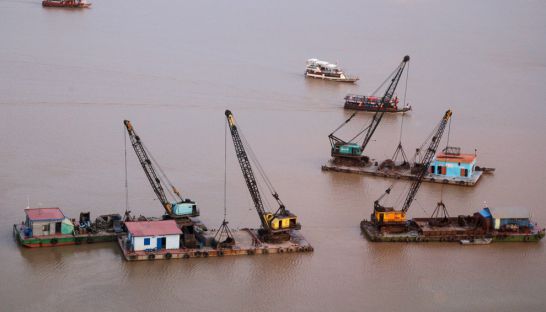Sand dredging licences secretly soaring
Sand dredging licences secretly soaring
Despite the government’s vow to be more transparent with regulations and the issuing of sand-dredging licences, the Ministry of Mines and Energy (MME) has granted nearly 70 new such licences without holding public auctions or requiring companies to disclose environmental impact assessments (EIA) results to the public, according to data from the ministry.

As part of the reforms following a sand-dredging clampdown last March, when the MME announced that it would rein in the sector, numerous sand-dredging licences have continued to be issued.
While the most transparent public auction was held last June to issue four licences for dredging the Mekong and Tonle Bassac rivers, since then a total of 49 licences were awarded by the end of 2015 and 20 more during the first quarter of 2016 – bringing the nationwide total to 84, said Dith Tina, secretary of state at the Ministry of Mines and Energy.
Tina maintained that although many new licences have been issued, the ministry has stepped-up its effort to answer the concerns of villagers affected by sand dredging, using a riverbank collapse that occurred earlier this month as an example.
After the collapse in the Koh Thom district of Kandal, caused by the Lim Kao ChingGroup, the MME hosted a public forum attended by 400 villagers across eight different communes.
“After the public forum, the dredging boundary [was] marked on the river and people can see if the company dredges outside the boundary and we have a hotline that people can call in to report,” he said.
“The licence also stated that the company is allowed to dredge only from 6am to 6pm to avoid disturbing people in their resting time.”
He also said that a community fund has been created to compensate villagers, allocating a pool of $0.01 per cubic metre dredged. In addition, according to the ministry’s licencing structure, all sand dredgers must pay $2,478.90 for a licence, with the exception of “small scale” dredgers that need to pay $24.79.
According to the ministry’s documents, the government made over $4.1 million in sand dredging revenue last year and $1.62 million for the first quarter of 2016.
Despite Tina’s assurances that the government had adequately addressed issues caused by sand dredging, environmental activists maintain that dredging continues to have an impact on locals and the environment alike when proper procedures aren’t followed.
“There are laws in place like the law on mineral extraction but there has to be hydrological reports and environmental and social assessments,” said Alex Gonzalez-Davidson, the exiled founder of Mother Nature, an environmental group established in Koh Kong.
“Where are those reports? We’ve been asking for months. If they really wanted to do things according to the book they would release everything, EIA reports, hydrological reports, company names and numbers.”
He said that members in Koh Kong have sent letters to the ministry asking for transparency and official figures on how much the government is making from sand dredging, but inquires have been repeatedly ignored. Gonzalez added that members of the Koh Kong community have yet to see compensation from the losses from sand dredging practices.
“You have massive loss of livelihood because fish stocks have been depleted, sometimes 60, 80, or 90 per cent in communities that rely 100 per cent on fisheries,” he said, adding that this has left people with no choice but to migrate to other countries in search of work.
“There is also loss of potential revenue due to tourism, these places are very beautiful and have mangroves but when you have these large ships dredging night and day you aren’t going to get many tourists.”
The Phnom Penh Autonomous Port (PPAP), which received one of the publically auctioned licences last June to dredge on the Mekong, said that its operation does not pose environmental risks.
“PPAP and Ministry of Mines and Energy have made an agreement in which PPAP and sand dredging companies are supposed to study about the EIA, so we believe there is no impact on the environment,” said a spokesman from the PPAP statistics department.
“Those companies have to have licences from the Ministry of Mines and Energy and PPAP has only played the role of managing those companies who want to dredge in PPAP’s zones.”
According to the state-owned publicly listed company, the port made $715,000 from sand dredging last year.
The Ministry of Environment, meanwhile, insists that only the Ministry of Mines and Energy knows the environmental impacts of dredging.
“The Ministry of Mines and Energy has all the information to see if all of the licenced companies have done all of the necessary steps, as they are the ones who handle the licencing and have full information about these companies,” said Sao Sopheap, spokesman for the Ministry of Environment.
However, he added that the two ministries are supposed to work together to ensure that all requirements, especially the EIAs, are completed by the companies before being granted licences.













